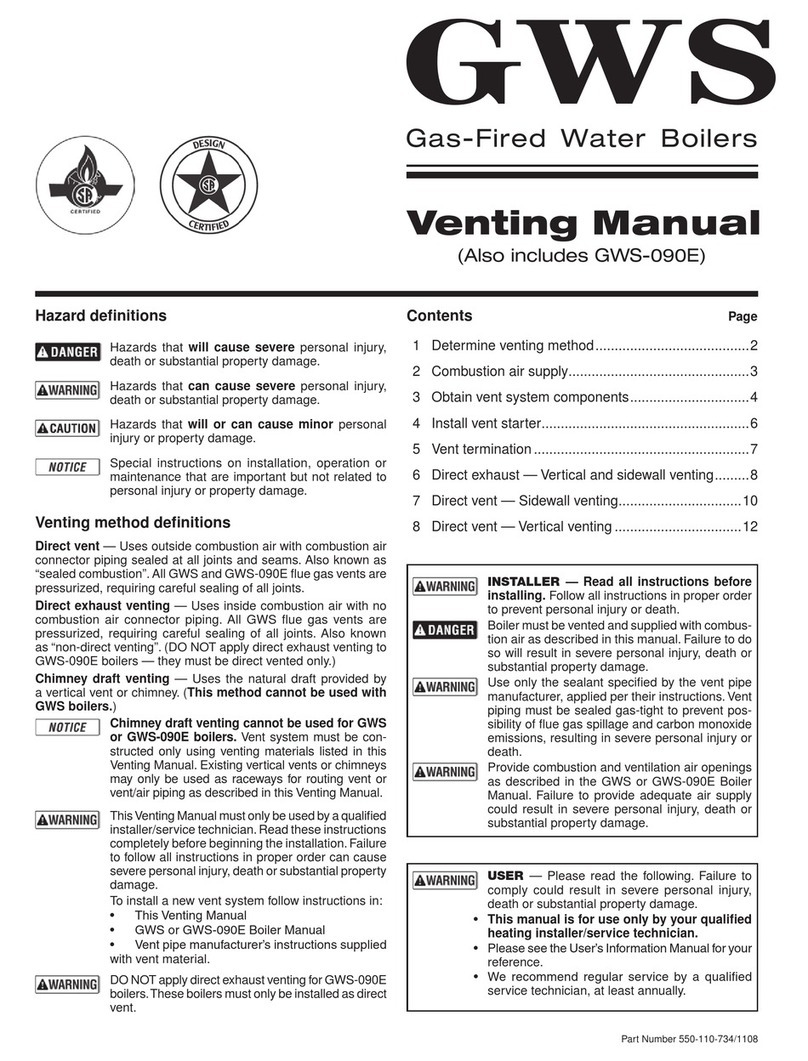
GWS
Gas-Fired Water Boilers – Boiler Manual
4Part Number 550-110-732/0703
1 Prepare boiler location continued
GWS special vent system required
Vent system
GWS boilers require a special vent system, designed for
pressurized venting. Model GWS-063 is rated ANSI Z21.13
Category IV (pressurized vent, likely to condense in the vent).
Models GWS-095, -127 and -158 are rated Z21.13 Category III
(pressurized vent).
You may use any of the vent systems covered in GWS Venting
Manual included in the boiler envelope assembly. The GWS vent
starter is a special item, designed only for GWS boilers, available
from each vendor. Do not attempt to connect the vent to a GWS
boiler with any other means.
DO NOT mix components from different systems.
The vent system could fail, causing leakage of flue
products into the living space.
Vent termination and combustion air supply
GWS boilers may be vented through the roof or through a side wall.
Follow the appropriate instructions in the GWS Venting Manual for
the vent system chosen. The maximum vent length depends on
boiler size. Refer to the GWS Venting Manual to determine
acceptable vent length.
Combustion air for GWS boilers may be from inside or ducted
directly to the boiler from outside. For outside air (direct vent
installation), two options are available for the flue/air termination.
The air supply must ALWAYS terminate at the same location as
the flue, using either:
1. Vertical direct vent installation — Obtain the Through-Roof or
Through-Unused Chimney Termination Kit. Refer to GWS
Venting Manual, packed with the kit and to the vent
manufacturer’s instructions for the vent material chosen.
2. Sidewall direct vent installation — Use the Vent/Air Intake
Termination Kit shipped with the boiler. Refer to GWS Venting
Manual shipped with the boiler.
Failure to follow all instructions can result in flue gas
spillage and carbon monoxide emissions, causing
severe personal injury or death.
Do not install the GWS into a common vent with any
other appliance. This will cause flue gas spillage or
appliance malfunction, resulting in possible severe
personal injury, death or substantial property damage.
Inspect existing chimney before installing boiler.
Failure to clean or replace perforated pipe or tile lining
will cause severe personal injury or death.
GWS boilers can be either direct-vent vented or
direct-exhaust vented.They cannot be chimney-draft
vented. See GWS Venting Manual for detailed
installation instructions.
If you are removing an existing boiler from a shared
venting system, the new GWS boiler cannot share
the vent system. You must test each appliance
remaining on the common vent system individually
to verify the vent system still operates adequately.
Follow guidelines below.
When removing boiler from existing common vent
system:
At the time of removal of an existing boiler, the following steps shall
be followed with each appliance remaining connected to the common
venting system placed in operation, while the other appliances
remaining connected to the common venting system are not in
operation.
a. Seal any unused openings in the common venting system.
b. Visually inspect the venting system for proper size and horizontal
pitch and determine there is no blockage or restriction, leakage,
corrosion or other deficiencies which could cause an unsafe
condition.
c. Test vent system — Insofar as is practical, close all building
doors and windows and all doors between the space in which
the appliances remaining connected to the common venting
system are located and other spaces of the building. Turn on
clothes dryers and any appliance not connected to the common
venting system.Turn on any exhaust fans, such as range hoods
and bathroom exhausts, so they will operate at maximum speed.
Do not operate a summer exhaust fan. Close fireplace dampers.
d. Place in operation the appliance being inspected. Follow the
lighting/operating instructions. Adjust thermostat so appliance
will operate continuously.
e. Test for spillage at draft hood relief opening after 5 minutes of
main burner operation. Use the flame of a match or candle.
f. After it has been determined that each appliance remaining
connected to the common venting system properly vents when
tested as outlined above, return doors, windows, exhaust fans,
fireplace dampers, and any other gas-burning appliance to their
previous conditions of use.
Any improper operation of common venting system should be
corrected so the installation conforms with the National Fuel Gas
Code, ANSI Z223.1 – latest edition. Correct by resizing to approach
the minimum size as determined using the appropriate tables in
Part 11 of that code.Canadian installations must comply with B149.1
or B149.2 Installation Code.
Vent system




























